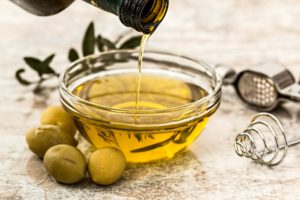Chef
What Type of Fat Should I Cook With?

By Jennifer Reha, UTSA Graduate Dietetic Intern
Revised by Celina Paras MSc, RDN, LD.
“Cook with this fat. Don’t cook with that fat.” With so much information on the internet changing daily, it can be confusing when trying to make better nutrition choices. Fats are an important part of our diet; they keep our cells happy, help us absorb vitamins, and are needed for keeping our body, including our brain and heart, at 100%. So, what fat should you cook with?
Types of Fats
All fats contain 3 kinds of fatty acids that have different effects on our body. Fats that contain mostly saturated fatty acids are primarily solid at room temperature. Sources of saturated fat include palm oil, butter, beef fat, or chicken fat. Fats that contain mostly unsaturated fatty acids are usually liquid at room temperature. Sources of unsaturated fats include olive, canola, peanut, soybean, corn, or sunflower oils, seafood, or avocados. Essential fatty acids, which must be obtained via diet, are found in unsaturated fats. Research suggests that excess saturated fat may be associated with a higher risk for heart disease, whereas unsaturated fats may decrease one’s risk; this is why it is important to know which type of fat you are cooking with.
Cooking
Some fats are more fragile than others. Fats have a smoke point, which means the point at which the fat molecules are broken down and smoke is produced. After this point, there may be undesirable flavor and compositional changes. Reheating of fats to reuse in the cooking process is not recommended as this may alter the composition of the fat, lower the smoke point, and increase the risk for production of unstable compounds. In degrees Fahrenheit, extra virgin olive oil (EVOO) has a smoke point around 375, canola oil has one around 400, flax seed oil has one of around 225, butter has one around 250, and avocado oil has one of around 570.
Considerations
At the grocery store, there is an extensive selection of various oils with an wide range of cost. To maximize on an oil’s properties, make sure to buy a pure form of the oil and not a blend or refinement. Along with cost, the type of dish and method of preparation must be considered, especially if one is also considering the flavor of oil to use. For example, if one owned EVOO and canola oil, one may use canola oil when stir frying because the oil flavor will not be as noticeable compared to adding an oil directly on to pasta to consume, which EVOO may be a better option to enhance the flavor. This would be cost and flavor effective.
In general, cooking at home with family is a positive experience. With the goal of healthy eating patterns in mind, swapping saturated fat and replacing it with unsaturated fat may increase potential health benefits. Keep these tips in mind next time you are strolling down the cooking oil section or trying to decide which fat to cook with!
Sources:
- USDA & HHS. 2015-2020 Dietary Guidelines for Americans. 8th ed, 2015: http://health.gov/dietaryguidelines/2015/guidelines/.
- Mishra S, Manchanda S. Cooking oils for heart health. J Prev Cardiol. 2012;1:123-131.
- Katragadda HR, Fullana A, Sidhu S, Carbonell-Barrachina ÁA. Emissions of volatile aldehydes from heated cooking oils. Food Chemistry. 2010;120(1):59-65.
- Moncel B. Smoking Points of Fats and Oils. 2018; https://www.thespruce.com/smoking-points-of-fats-and-oils-1328753. Accessed March 30, 2018.
Notes
Source 11
Source 22
Source 33
Source 44
- HHS Ua. 2015-2020 Dietary Guidelines for Americans. 8th ed2015: http://health.gov/dietaryguidelines/2015/guidelines/.
- Mishra S, Manchanda S. Cooking oils for heart health. J Prev Cardiol. 2012;1:123-131.
- Katragadda HR, Fullana A, Sidhu S, Carbonell-Barrachina ÁA. Emissions of volatile aldehydes from heated cooking oils. Food Chemistry. 2010;120(1):59-65.
- Moncel B. Smoking Points of Fats and Oils. 2018; https://www.thespruce.com/smoking-points-of-fats-and-oils-1328753. Accessed March 30, 2018.



